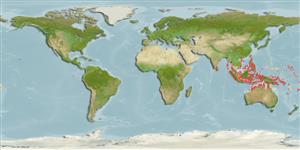Common names from other countries
Environment: milieu / climate zone / depth range / distribution range
Ecologia
marinhas associadas(os) a recifes; intervalo de profundidade 8 - 25 m (Ref. 9710). Tropical; 25°N - 18°S
Western Pacific: Japan to Western Australia and the Solomon Islands.
Tamanho / Peso / Idade
Maturity: Lm ? range ? - ? cm
Max length : 10.0 cm TL macho/indeterminado; (Ref. 9710)
Espinhos dorsais (total) : 1 - 2; Raios dorsais (total) : 29 - 33; Espinhos anais: 0; Raios anais : 25 - 30. Dark brownish green to grayish green head and back, lower portions noticeably whitish; dark brown to pale orange iris; dark brown lips. Caudal fin membranes usually orange anteriorly, dusky posteriorly; other fins clear; spinous dorsal similar to body color. Pelvic fin rudiment moderate in size, broadly attached to posterior margin of ventral flap. Midbody scales variable in size. Scale rugosities in males usually develop at about 50 mm SL. Varies considerably with respect to squamation, coloration, fin-ray counts and max. size across its range.
Secretive species found in lagoon and protected seaward reefs (Ref. 9710, 48637), often in silty conditions. Solitary (Ref. 90102). Sometimes seen deep inside branching corals (Ref. 48637). Has been from deeper water by trawls.
Ciclo de vida ou comportamento de acasalamento
Maturities | Reprodução | Spawnings | Egg(s) | Fecundities | Larvas
Hutchins, J.B., 1986. Review of the monacanthid fish genus Pervagor, with descriptions of two new species. Indo-Pac. Fish. (12):35 p. (Ref. 527)
Status na Lista Vermelha da UICN (Ref. 130435)
CITES (Ref. 128078)
Not Evaluated
Ameaça para os humanos
Harmless
Uso pelos humanos
Ferramentas
Relatórios especiais
Baixar XML
Fontes da internet
Estimates based on models
Preferred temperature (Ref.
115969): 27.8 - 29.3, mean 28.8 (based on 1722 cells).
Índice de diversidade filogenética (Ref.
82804): PD
50 = 0.5039 [Uniqueness, from 0.5 = low to 2.0 = high].
Bayesian length-weight: a=0.01995 (0.00943 - 0.04220), b=2.93 (2.75 - 3.11), in cm Total Length, based on LWR estimates for this (Sub)family-body shape (Ref.
93245).
Nível Trófico (Ref.
69278): 2.9 ±0.4 se; based on size and trophs of closest relatives
Resiliência (Ref.
120179): Elevada, tempo mínimo de duplicação da população menor que 15 meses (Preliminary K or Fecundity.).
Fishing Vulnerability (Ref.
59153): Low vulnerability (10 of 100).
